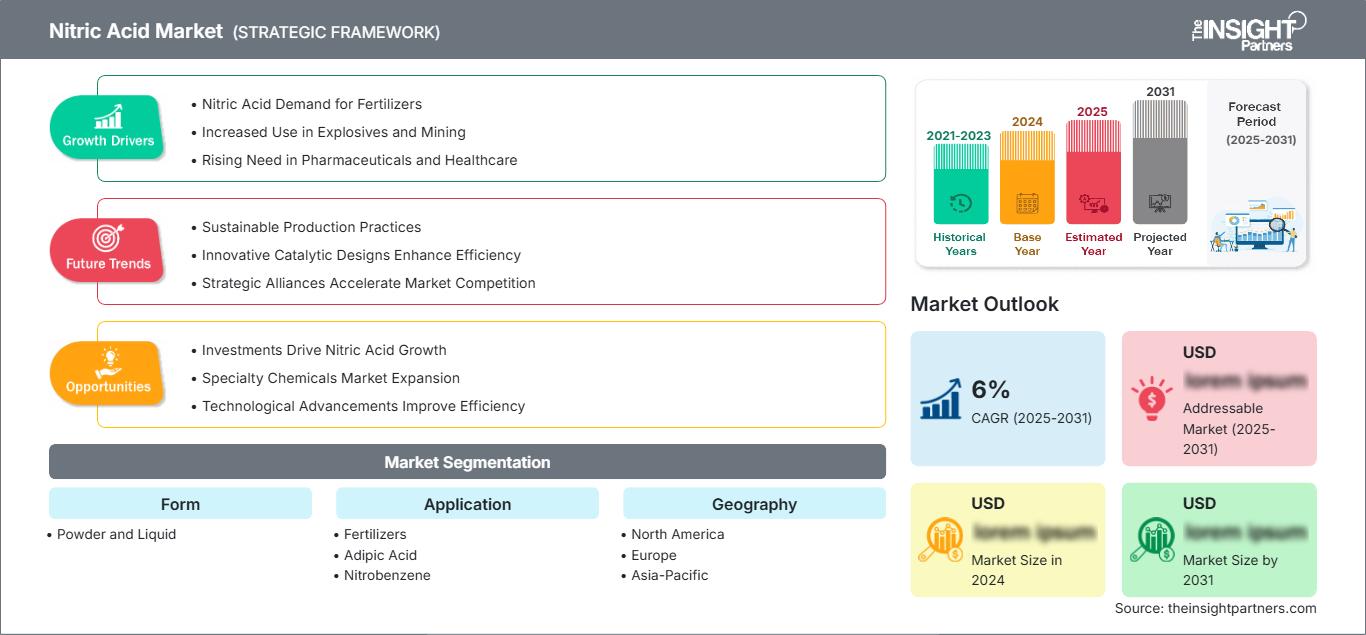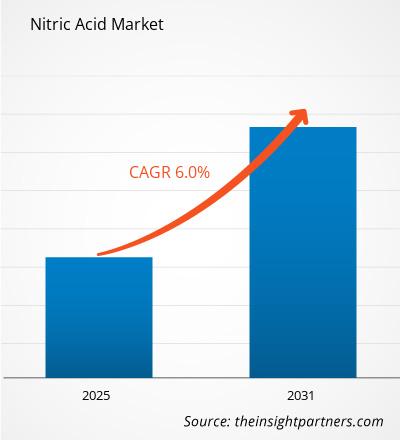页面已更新 :
Jan 2025
预计硝酸市场在 2025 年至 2031 年期间的复合年增长率为 6%,市场规模将从 2024 年的 XX 百万美元扩大到 2031 年的 XX 百万美元。
该报告按形态(粉末和液体)细分。报告进一步根据应用(肥料、己二酸、硝基苯、甲苯二异氰酸酯、硝基氯苯等)进行了分析。全球分析进一步细分为区域和主要国家。该范围涵盖所有主要细分市场的全球、区域和国家层面的市场规模和预测。该报告以美元提供上述分析和细分市场的价值。该报告提供了主要市场参与者的市场状况的关键统计数据,并提供了市场趋势和机遇。
报告目的
Insight Partners 撰写的《硝酸市场》报告旨在描述现状和未来增长、主要驱动因素、挑战和机遇。这将为各种业务利益相关者提供见解,例如:
- 技术提供商/制造商:了解不断变化的市场动态并了解潜在的增长机会,使他们能够做出明智的战略决策。
- 投资者:对市场增长率、市场财务预测和整个价值链中存在的机会进行全面的趋势分析。
- 监管机构:规范市场政策和警察活动,旨在最大限度地减少滥用,维护投资者的信任和信心,并维护市场的完整性和稳定性。
硝酸市场细分形式
- 粉末和液体
应用
- 肥料
- 己二酸
- 硝基苯
- 甲苯二异氰酸酯
- 硝基氯苯及其他
自定义此报告以满足您的要求
您将免费获得任何报告的定制,包括本报告的部分内容,或国家级分析、Excel 数据包,以及为初创企业和大学提供超值优惠和折扣
硝酸市场: 战略洞察

- 获取本报告的主要市场趋势。这个免费样本将包括数据分析,从市场趋势到估计和预测。
硝酸市场增长动力
- 硝酸在肥料中的需求:硝酸市场主要受硝酸需求驱动,硝酸是生产氮基肥料的前体。粮食生产的质量与不断增长的人口密不可分,尤其是在发展中国家,那里的农作物几乎不加区分地使用化肥。由于硝酸是由硝酸铵和其他氮肥合成的农业用起始化合物,因此无法将其排除在外。而随着人们对粮食安全意识的不断增强以及对环保农业方法的需求不断增加,硝酸的需求也随之增加。
- 炸药和采矿业用量的增加:炸药生产促进了对硝酸的需求,硝酸与硝酸铵一起用于生产硝酸铵炸药。此类炸药广泛用于建筑业、采矿业和国防领域,用于各种用途。随着全球范围内基础设施建设和采矿活动的不断增加,对这些炸药的需求必将增加;因此,对硝酸的需求也将随之增加。这一策略在正在进行工业化发展中的国家最为有效。
- 制药和医疗保健领域需求的不断增长:硝酸也用于制药行业,以生产各种复杂的化学品和药物中间体。此外,由于人口增长和医疗保健趋势的推动,对治疗的需求不断增加,硝酸的需求也随之增加。随着制药行业专注于药物发现和开发,对注射药物的需求日益增长,而原材料(在本例中为硝酸)的质量要求也随之提高。
硝酸市场未来趋势
- 可持续生产实践:硝酸生产越来越倾向于采用可持续战略。越来越多的制造商正在实施更环保的生产方法,使用替代能源和废热回收系统。这些方法不仅可以减少硝酸生产的碳足迹,还能提高运营效率。因此,将可持续性融入商业模式的公司将在竞争中拥有更广阔的前景。
- 创新催化设计提升效率:近期更具成本效益的催化设计也推动了生产技术应用的增加,从而提高了硝酸的产量和纯度。制造商还通过速率控制反应器设计的创新和相关工艺的优化,提高了硝酸生产的效率,降低了成本和废料率。这些技术改进对于以经济可持续的方式实现预期的需求增长至关重要。
- 战略联盟加速市场竞争:近年来,亚硝酸生产公司、其最终用户和研究机构之间的战略联盟数量激增。此类伙伴关系旨在交换技术、研究和市场资源,实现互利共赢。市场参与者之间的此类联盟使他们能够缩短产品上市时间,培育新思路,并扩大业务的地域覆盖范围。这种发展加剧了硝酸市场的竞争,使其更加活跃。
硝酸市场机遇
- 投资推动硝酸增长:包括信息技术、现有设施改造以及新工厂和基础设施建设在内的各个领域的投资对于发展中市场硝酸行业的发展至关重要。此外,考虑到这些地区对化肥和炸药的需求(由于快速的工业化和城镇化以及农业实践的集约化而不断增长),这些进步也就不足为奇了,这些需求将转化为经济效益。随着针对这些地区的国内制造单位和供应链的启动,这一趋势带来了机遇。
- 特种化学品市场扩张:包括硝酸在内的特种化学品的潜在发展空间尚未得到充分开发。随着工业的日益复杂,制造商将硝酸引入其产品的可能性越来越大,包括电子产品、汽车和可再生能源。如果公司能够打造专业化产品(此处指专业化产品),就能进入其产品线通常无法触及的不同市场。
- 技术进步提升效率:智能制造等技术发展可以提高运营效率、减少停机时间并提升最终产品质量。应用软件进行流程再造和故障维护工作,将增强组织的竞争力,并降低运营成本。
硝酸市场
The Insight Partners 的分析师已详尽阐述了预测期内影响硝酸市场的区域趋势和因素。本节还讨论了北美、欧洲、亚太地区、中东和非洲以及南美和中美洲的硝酸市场细分和地域分布。
硝酸市场报告范围
| 报告属性 | 细节 |
|---|---|
| 市场规模 2024 | US$ XX million |
| 市场规模 2031 | US$ XX Million |
| 全球复合年增长率 (2025 - 2031) | 6% |
| 历史数据 | 2021-2023 |
| 预测期 | 2025-2031 |
| 涵盖的领域 |
By 形态
|
| 覆盖地区和国家 | 北美
|
| 市场领导者和主要公司简介 |
|
硝酸市场参与者密度:了解其对业务动态的影响
硝酸市场正在快速增长,这得益于终端用户需求的不断增长,而这些需求的驱动因素包括消费者偏好的不断变化、技术进步以及对产品优势的认知度不断提高。随着需求的增长,企业正在扩大产品线,不断创新以满足消费者需求,并抓住新兴趋势,从而进一步推动市场增长。

- 获取 硝酸市场 主要参与者概述
主要卖点
- 全面覆盖:本报告全面涵盖了对硝酸市场产品、服务、类型和最终用户的分析,提供了整体格局。
- 专家分析:本报告基于对行业专家和分析师的深入了解而编写。
- 最新信息:本报告涵盖了最新信息和数据趋势,确保了业务相关性。
- 定制选项:本报告可根据特定客户需求进行定制,并使其与业务战略相得益彰。
因此,这份关于硝酸市场的研究报告有助于引领解读和理解行业情景和增长前景的步伐。尽管可能存在一些合理的担忧,但本报告的总体优势往往大于劣势。
- 历史分析(2 年)、基准年、预测(7 年)及复合年增长率
- PEST和SWOT分析
- 市场规模、价值/数量 - 全球、区域、国家
- 行业和竞争格局
- Excel 数据集
近期报告
相关报告
客户评价
购买理由
- 明智的决策
- 了解市场动态
- 竞争分析
- 客户洞察
- 市场预测
- 风险规避
- 战略规划
- 投资论证
- 识别新兴市场
- 优化营销策略
- 提升运营效率
- 顺应监管趋势
我们的客户































87-673-9708

ISO 9001:2015



 获取免费样品 - 硝酸市场
获取免费样品 - 硝酸市场